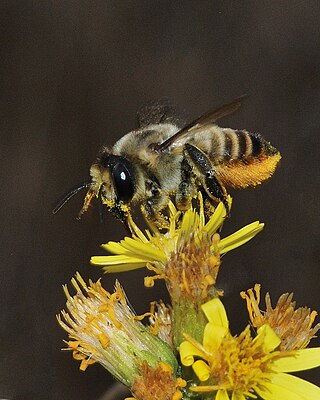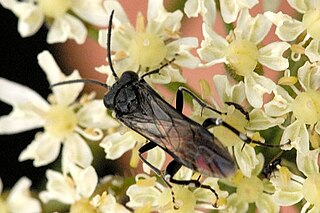
The Ichneumonidae, also known as ichneumon wasps, ichneumonid wasps, ichneumonids, or Darwin wasps, are a family of parasitoid wasps of the insect order Hymenoptera. They are one of the most diverse groups within the Hymenoptera with roughly 25,000 species currently described. However, this likely represents less than a quarter of their true richness as reliable estimates are lacking, along with much of the most basic knowledge about their ecology, distribution, and evolution. It is estimated that there are more species in this family than there are species of birds and mammals combined. Ichneumonid wasps, with very few exceptions, attack the immature stages of holometabolous insects and spiders, eventually killing their hosts. They thus fulfill an important role as regulators of insect populations, both in natural and semi-natural systems, making them promising agents for biological control.

The genus Megachile is a cosmopolitan group of solitary bees, often called leafcutter bees or leafcutting bees; it also includes the called resin bees and mortar bees. While other genera within the family Megachilidae may chew leaves or petals into fragments to build their nests, certain species within Megachile neatly cut pieces of leaves or petals, hence their common name. This is one of the largest genera of bees, with more than 1500 species in over 50 subgenera. The alfalfa leafcutter bee is managed on a commercial scale for crop pollination, and has been introduced by humans to various regions around the world.

Platygaster is a genus of parasitoid wasps in the family Platygastridae. There are more than 560 described species in Platygaster.
Anteris is a genus of wasps in the family Platygastridae. There are about 15 described species in Anteris.
Oethecoctonus oecanthi is a species of parasitoid wasp in the family Platygastridae.
Synopeas hopkinsi is a species of parasitoid wasp in the family Platygastridae.
Synopeas is a genus of parasitoid wasps in the family Platygastridae. There are about 400 described species in Synopeas.

Heloridae is a family of wasps in the order Hymenoptera known primarily from fossils, and only one extant genus, Helorus, with 12 species found worldwide. Members of Helorus are parasitic on green lacewings.
Oethecoctonus is a genus of parasitoid wasps in the family Platygastridae. There are about six described species in Oethecoctonus.

Teleasinae is a subfamily of wasps in the family Platygastridae. There are about 14 genera and more than 250 species in Teleasinae.

Monophadnoides rubi, the raspberry sawfly, is a species of common sawfly in the family Tenthredinidae.

Monophadnoides is a genus of common sawflies in the family Tenthredinidae. There are about eight described species in Monophadnoides.
Macroteleia carinata is a species of parasitoid wasp in the family Platygastridae.

Macroteleia is a genus of parasitoid wasps in the family Platygastridae. There are more than 140 described species in Macroteleia.
Dasineura parthenocissi is a species of gall midge, insects in the family Cecidomyiidae. It forms galls on Parthenocissus quinquefolia. The gall can host the parasitic wasp Platygaster munita.
Platygaster munita is a species of parasitoid wasp in the family Platygastridae. It is found in Europe.
Trichacis virginiensis is a species of parasitoid wasp in the family Platygastridae.

Pison morosum is a solitary wasp of the family Crabronidae. It is the only endemic species of Pison wasp to New Zealand. It was first described by entomologist Frederick Smith in 1858.







